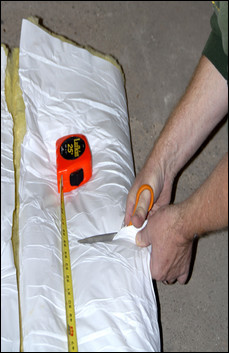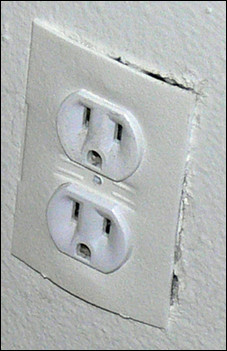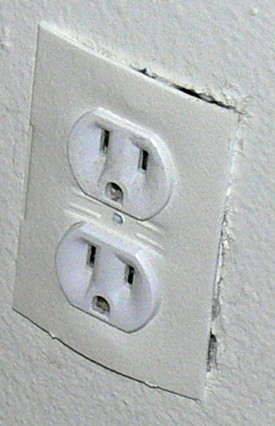Many homeowners will have to deal with big heating bills this winter. To keep those bills as low as possible, Renovate Your World has come up with 20 suggestions.
 You may have to cut an insulation blanket to fit your water heater. Be sure to follow manufacturer’s instructions which will differ for electric and gas- or oil-fired water heaters. (c) Maureen Blaney Flietner |
1. Schedule an energy audit. Look for a reputable inspector with high-tech equipment who can determine whether there is enough insulation in the right places and if there are any air leaks. An audit typically includes a prioritized list of remedies and estimated savings. Check for auditors through state home energy programs or through RESNET, an industry not-for-profit membership corporation, which offers an online rater directory. Many communities offer free energy audits, too, so contact your town hall for more information. For more information about energy audits, see “Four Fixes to Stop Home Energy Leaks."
2. Don’t heat unused rooms. Close the registers, draw the drapes and shut the door. Provide just enough heat to those rooms to prevent frozen water pipes during frigid weather.
3. Let the sun shine in. On bright winter days, the Sun’s low angle brings light streaming into your south-facing windows along with free solar heat. Close drapes at night and keep them closed on blustery, gray days. Consider insulated drapes or curtains. Make sure drapery and furniture don’t block heat vents.
4. Remedy leaky windows. If your windows are single-pane, replace them with high-efficiency models. Not in the budget? Here are other options. Caulk around windows using appropriate products. Create interior storm windows with heavy-duty plastic or use a kit. Kits typically involve attaching supplied clear plastic to the frame with double-stick tape. You may have to use a hair dryer to shrink the plastic to fit. Carefully remove interior window trim and use water-based low-expanding foam to seal any gaps between windows and walls. Weatherstrip between sash and frame. See our How To Video, “Weatherstripping Doors and Windows for Energy Savings” for step-by-step instructions.
 Fire-retardant precut foam insulation forms install easily behind electrical outlet faceplates. (c) Maureen Blaney Flietner |
5. Maintain heating systems. Schedule annual service with your heating contractor to make sure the system works at peak efficiency. Replacing an old filter can save as much as five percent on your heating costs and it’s simple to do. Here’s how: “Replacing a Filter for a Forced Air Heating System.” If you burn wood or pellets, clean the flue vent and follow manufacturer maintenance recommendations.
6. Reduce water heater temperature to 120 degrees F. Some water heater thermostats come preset at 140 degrees F., which is scalding hot. Most households only need water at 110 to 120 degrees F. According to the U.S. Department of Energy, each 10 degree F drop in temperature saves three to five percent in energy costs. Review the owner’s manual to see how to adjust the thermostat. If you have a dishwasher without a booster heater, you may have to keep the temperature high.
7. Insulate the water heater. Many newer water heaters contain insulation but some do not. Touch your water heater. If it is warm, it could use an insulation jacket. Follow manufacturer’s directions. There are some caveats. Don’t install an insulation jacket on an electric water heater set higher than 130 degrees F and leave the thermostat access panel uncovered. Keep the insulation jacket on a gas- or oil-fired water heater away from the drain and flue. Follow manufacturer directions. Here’s how to easily insulate your water heater as well as pipes and attic spaces.
8. Get on a budget plan. Call your utility and find out about being switched to budget billing. A budget plan takes the annual utility cost and divides it by 12, easing the expensive peaks of cold winter months. If you have a separate heating fuel supplier, check lock-in plans and decide if one is right for you. Read the fine print.
9. Change ceiling fans to the winter setting. Heat rises so make use of it. Flip the toggle on a ceiling fan to send it in a clockwise direction. It will bring colder air up and send the warmer air at the ceiling down along the walls. Set the speed on low so the fan does not create a draft.
10. Seal penetrations into the basement. Use caulk or insulating foam where plumbing pipes, electric wires, ducting vents and other lines pass through basement walls.
 Follow manufacturer’s directions when using a water-based foam insulation to spray small gaps between window and wall under window trim. (c) Maureen Blaney Flietner |
11. Remove or cover room air conditioners. If you can, remove them for the season. If you can’t, use tight-fitting covers, preferably ones that have insulated liners.
12. Limit run time for exhaust fans. Let exhaust fans run for a maximum of 20 minutes after you are done cooking or bathing. If the bathroom exhaust fan is letting cold air drop down, replace it with a high-efficiency model that includes a damper.
13. Insulate electric outlets. Put your hand in front of an electric outlet on an exterior wall on a blustery day. Feel a breeze? Turn off power and install insulating gaskets behind outlet and switch plates.
14. Take care of exterior doors. An older exterior door still in good condition will benefit from the addition of a high-quality storm door. Check door sweeps to determine if new weatherstripping is needed. If it is, choose a product that can handle the weather, wear and tear of its location and seal well when the door is closed.
15. Install a programmable thermostat. This device offers various energy-saving options, such as automatically adjusting for a cooler nighttime setting and then bringing temperatures up a bit before get up for the day. The thermostat must fit the heating system—those with heat pumps need one that reduces use of auxiliary electric resistance heat and those with electric baseboard heaters need one that directly controls line voltage circuits. Installing a programmable thermostat is a fairly easy DIY project. Here’s our video showing you just how to do it.
16. Insulate and seal the attic. Seal with spray foam any utility penetrations that run from basement or crawlspace into the attic. Add enough insulation to meet DOE recommendations for your area. Insulate the attic scuttle and weatherstrip the scuttle door. Here’s how.
17. Seal ducts. Leaky ducts don’t let heat get where it is intended. Seal joints with a shiny foil tape with a UL-181 label, duct mastic or duct sealant. Insulate ducts that travel through un-insulated spaces.
18. Wash clothes in cold water. Save the fuel costs to heat you and your family, not water for clothes that can be cleaned in cold water.
19. Check the fireplace. When the fireplace is not in use and the damper is left open, warm air escapes out the chimney. Make sure the seal on the damper is in good condition and close it tightly when the fireplace is not in use.
20. Turn down the thermostat. Wear layers and slippers. Experts say one percent on heating bills can be saved with each degree the thermostat is set back if the setback period is at least eight hours. The National Institutes of Health, however, does advise that seniors set their thermostats for at least 68 to 70 degrees in the winter and that babies should sleep in rooms at a temperature that is comfortable for an adult.
Credit: Renovate Your World




























